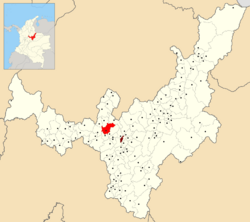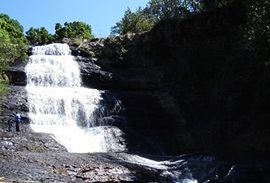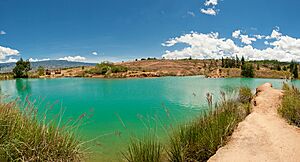Villa de Leyva facts for kids
Quick facts for kids
Villa de Leyva
|
|||
|---|---|---|---|
|
Church of Nuestra Señora del Rosario
|
|||
|
|||
| Nickname(s):
Villa de Nuestra Señora
de Santa María de Leyva |
|||

Location of the town of Villa de Leyva and the Leyva municipality in Boyacá Department
|
|||
| Country | |||
| Department | Boyacá Department | ||
| Province | Ricaurte Province | ||
| Founded | June 12, 1572 | ||
| Founded by | André Diaz Venero de Leyva | ||
| Area | |||
| • City | 128 km2 (49 sq mi) | ||
| Elevation | 2,149 m (7,051 ft) | ||
| Population | |||
| • City | 16,984 | ||
| • Density | 132.7/km2 (343.7/sq mi) | ||
| • Urban | 9,926 | ||
| Time zone | UTC-5 (Colombia Standard Time) | ||
| Website | Official website: http://www.villadeleyva-boyaca.gov.co/ | ||
Villa de Leyva, also known as Villa de Leiva, is a beautiful old town in Colombia. It's a popular place for tourists to visit. This town is located in the Boyacá Department, which is a part of Colombia.
Villa de Leyva is very special because it has kept its original colonial style for over 400 years. The streets and the main square are still covered with cobblestones. Many buildings are from the 1500s! Because of its well-preserved look, it was named a National Monument in 1954.
The town is about 37 kilometers (23 miles) west of Tunja, the capital of Boyacá. It's also about a three-hour drive from Bogotá, Colombia's capital city. Many people from Bogotá visit Villa de Leyva on weekends. More and more tourists from other countries are discovering this charming place too.
The area around Villa de Leyva has cool temperatures and dry weather. This makes it a good place for growing grapes. Because of this, several wineries have started up around the town in recent years.
Contents
Geography of Villa de Leyva
The main part of Villa de Leyva is in a valley. This valley is surrounded by mountains. It's part of a high plateau called the Altiplano Cundiboyacense. The town sits at an elevation of about 2,149 meters (7,051 feet) above sea level.
History of Villa de Leyva
The area where Villa de Leyva is located has been lived in for a very long time. Long before the Spanish arrived, the Muisca people lived here. They were an important group in this region.
One ancient site near the town is called El Infiernito. It's an old place used by the Muisca people to study the stars. This site dates back to times even before the Herrera Period. The Muisca leader, called the zaque of Hunza, ruled over this area.
The town of Villa de Leyva was officially started on June 12, 1572. It was named after Andrés Díaz Venero de Leiva. He was the first president of the New Kingdom of Granada, which was a Spanish colony.
Fun Things to Do in Villa de Leyva
Villa de Leyva is known for its many festivals and events. There's always something happening!
Festivals and Events
- Food Festival: Held in November, it's a great chance to try local dishes.
- Water Festival: Celebrates the importance of water.
- Tree Festival: Focuses on nature and trees.
- Jazz Festival: In July, you can enjoy live jazz music.
- International Kite-flying Festival: In August, the sky fills with colorful kites.
- Onion Beauty Pageant: A unique and fun event in October.
- Festival of Lights: On December 7, the town lights up beautifully.
You can also find music, art, and theater shows all year round. Many restaurants have live music. Storytellers often perform in the main square, entertaining visitors. Renting bikes is a popular way to explore the town and its surroundings.
Exploring the Town Center
The heart of Villa de Leyva is the Plaza Mayor. This huge square is about 14,000 square meters (150,000 square feet). It's the largest square in Colombia and possibly the largest fully cobbled square in South America!
Famous People and Museums
Villa de Leyva is home to several important historical sites:
- Antonio Ricaurte's House: Antonio Ricaurte (1797–1814) was a hero who fought for Colombia's independence. His birthplace is now a military museum.
- Antonio Nariño's House: Antonio Nariño was famous for translating "The Rights of Man" into Spanish. He was a key figure in the fight for independence. His house is now a museum with his personal belongings.
- Luis Alberto Acuña's House: Luis Alberto Acuña (1904–1993) was a very important Colombian artist. His home is now a museum showing his artworks, including murals.
- House of the First Congress: This building is where the first Congress of the United Provinces of Nueva Granada met in 1812. Today, it's where the local government council meets.
Natural Attractions Nearby
- Iguaque National Park: To the northeast of Villa de Leyva, you'll find this beautiful cloud-forest national park.
- La Periquera Waterfalls: About 15 kilometers (9 miles) from town, these are a group of seven lovely waterfalls.
- Pozos Azules: These are unique blue-colored pools of water in the semi-desert area.
In 2010, Villa de Leyva was named a Pueblo Patrimonio (heritage town) of Colombia. This means it's recognized for its historical and cultural value.
Ancient Fossils in Villa de Leyva
The valley around Villa de Leyva is famous for its many fossils. These fossils are from the Cretaceous period, which was millions of years ago!
The most famous fossil is a nearly complete Monquirasaurus. It was found in 1977, about 3 kilometers (2 miles) west of the town. This amazing fossil, known as El Fósil, was left where it was found. A museum was built around it so everyone could see it. Another smaller Monquirasaurus fossil is also displayed there.
Other ancient sea creatures found here include:
- Platypterygius sachicarum (an ichthyosaur)
- Muiscasaurus catheti (another ichthyosaur)
- Padillasaurus leivaensis (a brachiosaur)
- Stenorhynchosaurus (a pliosaur)
These discoveries make Villa de Leyva a very important place for studying ancient life!
Climate of Villa de Leyva
| Climate data for Villa de Leyva, elevation 2,215 m (7,267 ft), (1981–2010) | |||||||||||||
|---|---|---|---|---|---|---|---|---|---|---|---|---|---|
| Month | Jan | Feb | Mar | Apr | May | Jun | Jul | Aug | Sep | Oct | Nov | Dec | Year |
| Mean daily maximum °C (°F) | 23.4 (74.1) |
23.7 (74.7) |
23.6 (74.5) |
23.2 (73.8) |
23.0 (73.4) |
22.5 (72.5) |
22.3 (72.1) |
22.6 (72.7) |
23.0 (73.4) |
22.9 (73.2) |
22.4 (72.3) |
22.9 (73.2) |
23.0 (73.4) |
| Daily mean °C (°F) | 16.7 (62.1) |
17.1 (62.8) |
17.2 (63.0) |
17.3 (63.1) |
17.2 (63.0) |
17.1 (62.8) |
16.8 (62.2) |
16.9 (62.4) |
17.0 (62.6) |
16.7 (62.1) |
16.7 (62.1) |
16.6 (61.9) |
16.9 (62.4) |
| Mean daily minimum °C (°F) | 10.0 (50.0) |
10.7 (51.3) |
11.3 (52.3) |
11.8 (53.2) |
11.8 (53.2) |
11.3 (52.3) |
10.8 (51.4) |
10.9 (51.6) |
10.8 (51.4) |
11.0 (51.8) |
11.3 (52.3) |
10.7 (51.3) |
11.0 (51.8) |
| Average precipitation mm (inches) | 50.2 (1.98) |
71.1 (2.80) |
115.3 (4.54) |
123.0 (4.84) |
106.7 (4.20) |
41.8 (1.65) |
39.7 (1.56) |
40.2 (1.58) |
67.4 (2.65) |
148.9 (5.86) |
119.2 (4.69) |
83.0 (3.27) |
997.2 (39.26) |
| Average precipitation days (≥ 1.0 mm) | 9 | 11 | 14 | 16 | 15 | 10 | 10 | 9 | 11 | 17 | 17 | 12 | 149 |
| Average relative humidity (%) | 75 | 74 | 76 | 77 | 77 | 75 | 73 | 71 | 72 | 77 | 79 | 77 | 75 |
| Mean monthly sunshine hours | 195.3 | 163.7 | 151.9 | 120.0 | 133.3 | 141.0 | 158.1 | 158.1 | 141.0 | 133.3 | 135.0 | 167.4 | 1,798.1 |
| Mean daily sunshine hours | 6.3 | 5.8 | 4.9 | 4.0 | 4.3 | 4.7 | 5.1 | 5.1 | 4.7 | 4.3 | 4.5 | 5.4 | 4.9 |
| Source: Instituto de Hidrologia Meteorologia y Estudios Ambientales | |||||||||||||
Images for kids
-
El Infiernito, an ancient site for studying stars
-
The house where Antonio Nariño lived
See also
 In Spanish: Villa de Leyva para niños
In Spanish: Villa de Leyva para niños
































